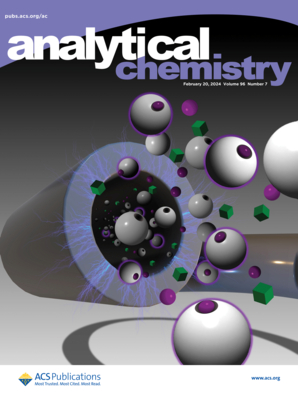IgA1抗体上聚糖的单分子动力学指纹图谱。
IF 6.7
1区 化学
Q1 CHEMISTRY, ANALYTICAL
引用次数: 0
摘要
免疫球蛋白A (IgA)肾病是原发性肾小球肾炎最常见的形式,是由糖基化IgA1抗体(“半乳糖缺乏”)和针对这些异常蛋白的抗体之间形成的复合物沉积对肾小球造成损害而引发的。目前,半乳糖缺乏症是通过集合测量来检测的,例如通过质谱法或液相色谱法,这些方法只能测量聚糖-IgA1的平均比率,但不能解决不同IgA1群体之间o -糖基化的异质性。为了在单分子水平上解决这些差异,我们开发了一种检测方法,使用单分子荧光显微镜检测单个IgA1的糖基化状态。利用荧光共振能量转移(fluorescence resonance energy transfer, FRET)技术,可以利用低结合率的高浓度荧光标记探针,观察蛋白质探针与表面粘附靶分子的结合,获得其动力学指纹图谱。我们测量了jacalin(一种与o -链聚糖结合的凝集素)与玻璃表面上单个IgA1分子的结合和解结合率。加入半乳糖减少了结合,这表明jacalin探针特异性地结合了IgA1铰链区域上的o -链聚糖。这一结果是利用动态指纹法对IgA1上的聚糖进行测序的第一步。本文章由计算机程序翻译,如有差异,请以英文原文为准。
Single Molecule Kinetic Fingerprinting of Glycans on IgA1 Antibodies.
Immunoglobulin A (IgA) nephropathy is the most common form of primary glomerulonephritis and is triggered by damage to glomeruli from deposition of complexes formed between glycosylated IgA1 antibodies that are "galactose-deficient" and antibodies directed to these aberrant proteins. Currently, galactose deficiencies are detected with ensemble measurements, e.g., via mass spectrometry or liquid chromatography, which only measure average glycan-IgA1 ratios, but cannot resolve heterogeneity of O-glycosylation between different IgA1 populations. To resolve these differences at the single molecule level, we developed an assay to detect the glycosylation state of individual IgA1 using single molecule fluorescence microscopy. By using fluorescence resonance energy transfer (FRET), high concentrations of fluorescently labeled probes with low binding rates can be employed to observe the binding of protein probes to surface adhered target molecules and obtain their kinetic fingerprints. We measured the binding and unbinding rates of jacalin (a lectin binding to O-linked glycans) to individual IgA1 molecules on a glass surface. Adding galactose decreased binding, which demonstrated that the jacalin probe binds specifically to O-linked glycans on the hinge region of IgA1. This result is a first step toward using kinetic fingerprinting to sequence glycans on IgA1.
求助全文
通过发布文献求助,成功后即可免费获取论文全文。
去求助
来源期刊

Analytical Chemistry
化学-分析化学
CiteScore
12.10
自引率
12.20%
发文量
1949
审稿时长
1.4 months
期刊介绍:
Analytical Chemistry, a peer-reviewed research journal, focuses on disseminating new and original knowledge across all branches of analytical chemistry. Fundamental articles may explore general principles of chemical measurement science and need not directly address existing or potential analytical methodology. They can be entirely theoretical or report experimental results. Contributions may cover various phases of analytical operations, including sampling, bioanalysis, electrochemistry, mass spectrometry, microscale and nanoscale systems, environmental analysis, separations, spectroscopy, chemical reactions and selectivity, instrumentation, imaging, surface analysis, and data processing. Papers discussing known analytical methods should present a significant, original application of the method, a notable improvement, or results on an important analyte.
 求助内容:
求助内容: 应助结果提醒方式:
应助结果提醒方式:


